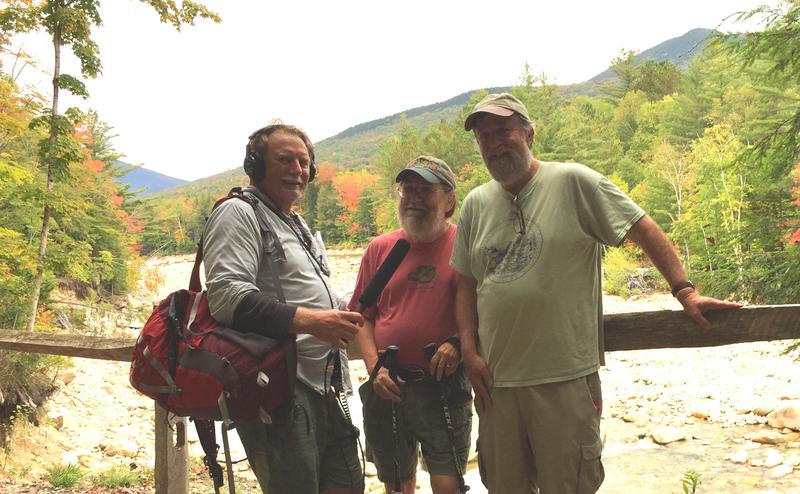A look at how hiking and hiking culture is changing in NH
- Tags:
- Recreation

Dave Anderson with Mike Dickerman and Steve Smith along the Pemigewassett Wilderness Trail at the Lincoln Woods Trailhead.
I rolled into the parking lot of the Mountain Wanderer Book Store in Lincoln, New Hampshire. I was there to meet two White Mountain hiking experts. Authors Mike Dickerman of Bond Cliff Books and Steve Smith, editor of the Appalachian Mountain Club’s White Mountain Hiking Guide. Steve also owns the Mountain Wanderer. From the bookstore, we drove to a nearby trail head for the Pemigewasset Wilderness Area in Lincoln.
The wooden bridge at the trail head is the gateway to 45,000 acres of protected land, in the heart of the White Mountain National Forest. As Smith points out, “Many a long journey has started here, and ended here.” We’re not far along our own journey when Smith and Dickerman begin swapping war stories from decades of walking these trails. Dickerman remembers breaking through the ice up to his waist; Smith remembers the difficulty of evacuating a member of one of his crew who had broken a leg on the trail.
These sorts of stories are rites of passage for any serious hiker, and no mistake these two are serious hikers, they co-authored The 400-Footers of the White Mountains, and have watched decades of change, from the hiking gear and tent technology, to hydration, but also with the community – on the peaks and on social media. “Back in the 1980's, it was strictly a weekend pursuit. Now every trailhead has a car at it every day,” says Dickerman. And on weekends parking can be problematic, even lining 93 through Franconia Notch. “I think the popularity of social media has brought more people out into the woods. People see something posted in online and say ‘Oh, I gotta try that.’”

Larger numbers of people enjoying New Hampshire’s natural resources has its advantages, but it is a two sided coin. Smith weighs them thus, “It’s Great to see all these people enjoying the mountain. Hopefully becoming advocates and stewards of the mountains. But, one of the issues is how do you reach all these new people that are getting out there.”
Dickerman worries about the safety of these novice hikers, he encourages hikers to be prepared for all weathers at any time of year. “Especially in the winter. People really push the envelope there. They’re bound and determined to get those peaks in no matter what the weather is. And there have been more than a few unfortunate fatalities over the years because of that.”
Steve has seen a lot of those trail injuries, too, as a member of the regional search and rescue crew. And he reminded us of another tip to keep yourself safe on the trail. “I always leave an itinerary and a map with my wife. That’s a basic tenant of the Hike Safe program.” The program administered by NH Fish and Game also encourage hikers to keep safe by knowing your gear, and staying with your group as you make your way along the trail.
And then there’s the matter of protecting the fragile environment and native species whose homes the mountain trails wind through. It’s tempting to step off the trail and explore other parts of the wilderness area, but Dickerman reminded us “how important it is for hikers to stay on the trail, getting off the trail you’re damaging these fragile alpine plants.”
At the same time, they’re wary of sounding too preachy, a challenge when the goal is to educate novice hikers. As Smith says, “we’re all part of the problem, whether we’ve been out there for 30 years or three weeks. We all contribute to the numbers of people on the trails.”
And the numbers aren’t likely to go down anytime soon. Smith said the siren’s call that is White Mountain hiking, is naturally the scenic beauty, “there’s a certain intimacy to the mountains here that people like. They’re accessible but you can go in a couple miles and feel like you’re a million miles from nowhere.”
Dickerman cites the variety of ground the trails cover, “it might be a valley walk, it might be a scramble up a steep little peak, you just never knew what you could do, and that’s what I like about the whites.”
Driving home that day I thought about how that intimacy and variety will always draw new hikers to the Whites. They don’t seem it, but these mountains are fragile. As Mike and Steve suggest, new hikers can become the best advocates for this mountain landscape.
